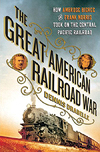 The Great American Railroad War: How Ambrose Bierce and Frank Norris Took on the Notorious Central Pacific Railroad, by Dennis Drabelle, St. Martin’s Press, New York, N.Y., 2012, $26.99
The Great American Railroad War: How Ambrose Bierce and Frank Norris Took on the Notorious Central Pacific Railroad, by Dennis Drabelle, St. Martin’s Press, New York, N.Y., 2012, $26.99
Showdowns are a staple of Wild West lore, but not all of them involved gunplay. In The Great American Railroad War Dennis Drabelle re-creates a “clash of titans” involving typewriters, money and politics, as a powerful railroad monopoly jumped the ethical tracks even for a time of anything-goes capitalism, to be assailed by two literary giants and one up-and-coming journalistic power.
The United States of the 19th century was an environment of seemingly limitless opportunity, unfettered by government regulation, and businessmen often pursued those opportunities with an unfettered ruthlessness regarded as all part of the capitalist game. In the 1860s, however, the government became involved in the national interest of completing a railroad linking east and west, including a $75 million loan to the Central Pacific Railroad—essentially, a form of selective socialism from which the Central Pacific profited royally once the transcontinental railroad was completed in 1869. By 1895, though, a surfeit of rail lines had led to a decline that left only a handful of railroad companies in control—and ill-disposed to pay the debt coming due. At that point Collis Huntington, the surviving member of the consortium that formed the Central Pacific, tried to avoid paying back the government or, failing that, have the government pass legislation that would consolidate his sizable debts into one that would be gradually paid off, at an interest rate of 2 to 3 percent, over another 75 years.
Many reform-minded American journalists looked askance at the abuse they believed monopolies inflicted on the free enterprise system. The prospect of one such industrial colossus seeking the taxpayers’ help to alleviate its risks and monetary problems represented a step over the line that Ambrose Bierce, the most vociferous of such critics, was unable to abide. Starting in January 1896, he launched a campaign, producing some 60 articles over five months, to oppose Huntington, heartily backed by his young, ambitious boss at The San Francisco Examiner, William Randolph Hearst. Huntington fought back with all the money and power at his disposal, buying the support of everyone from statesmen to counterattacking writers. A residual effect of this spirited contest was the inspiration of another noted author, Frank Norris, to turn a cartoon of the railroad monopolies into the title of one of the great “muckraker” novels of the Gilded Age, The Octopus.
For those wondering why there is a degree of government regulation within the American free enterprise system today, they may find an answer by revisiting the no-holds-barred slugfest of high-minded ideals, lowdown corruption and every shade of shadiness in between that pervades The Great American Railroad War. At the same time one might recognize more than a few aspects of capitalism that may look disturbingly familiar in the 21st century. In their own way the protagonists in this bygone conflict could be just as larger-than-life as those who traded shots at the O.K. Corral, and they were at it for more than just 30 seconds.
Jon Guttman




